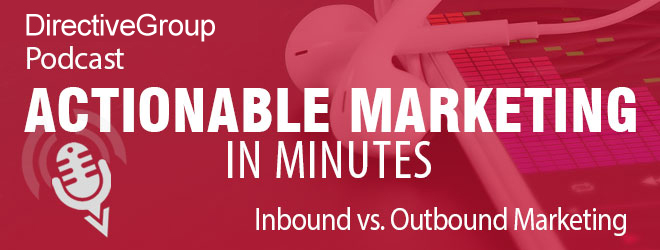In this episode of Actionable Marketing In Minutes we talk about: Inbound vs. Outbound Marketing.
Use the player below to listen to this episode, or the download link to load it on your device for listening later. You can also find our RSS feed by clicking here, or subscribe by email in the sidebar to the left.
Download our Marketing To Millennials eBook here!
Not able to listen? Why not read the episode transcript below:
Regardless of whether you have a brick or mortar store or solely do business on the internet, surely you are looking to connect to people who want or need your services or products. How will people know who/where you are and what you have to offer? How can you attract customers without any marketing effort? At the tactical level, the world of marketing is always in a state of flux but broadly speaking there are two main fundamentally different approaches to marketing – outbound marketing and inbound marketing. So how do you pick what is best for your business? For that you definitely need to know about the key differences between inbound and outbound marketing and benefits of each method.
Let’s start with outbound marketing, which involves sending messages out to the largest number of people possible. It relies on “in your face” or aggressive methods of advertising that interrupt what the buyer is doing to force attention on the products or services. For outbound marketing campaigns, the subject, timing and channel of interaction is dictated by the marketer and not the buyer.
In general, common outbound tactics to reach a larger volume of less-targeted people include:
· Television Commercials
· Pay Per Click ads
· Banner Advertising
· Cold-calling
· Direct mail lists
· Tradeshows
· Mass email marketing
· Flyers
Now, when we look at inbound marketing we see that the process naturally aligns your business with the buyer journey. It does not force information on an audience. Instead it brings potential active customers in the market to your business by making them aware of your existence and providing valuable information and advice. Inbound is all about marketing to prospects with consent and adapting your message as leads move through different stages of the buying process It gives prospects control of the time and place to engage with your business.
Typical examples of inbound marketing tactics that can lead to more opportunities and customers include:
· Blogging
· Social media
· Podcasts
· Email marketing
· Content creation (ebooks, whitepapers)
· Viral Videos
· SEO
Benefits:
Both forms of marketing have their benefits.
Look at your specific business goals, products and marketing objectives to determine which method is best suited for your business. It’s is about finding balance between both Inbound and Outbound approaches and using the right tool at the optimal time to get the best results.
We hope you’ve found this information helpful. Please connect with us on Twitter @DirectiveGroup or on LinkedIn. Let us know what you think and what you’d like to hear about next. And if you like our podcasts please share with your networks using hashtag #actionablemarketing.
